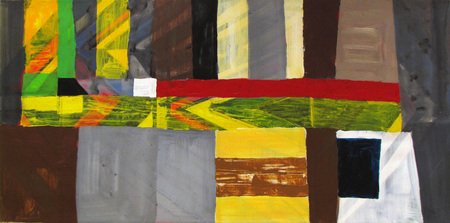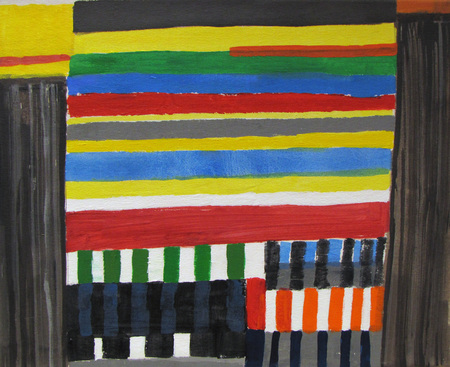Atta Kwami's 'Susuka' exhibit creates a true sense of place

“Kwahu Tafo”
Atta Kwami's exhbit "Susuka" at the University of Michigan Center for Afroamerican and African Studies Gallery can be seen as a sort of abstract cartography.
A leading Ghanaian artist and academician, Kwami resides in Kumasi, Ghana’s second-largest city and major cultural center. He was until recently a senior lecturer in the at Kumasi’s KNUST College of Art. His current projects include painting; printmaking; and art history (his 2007 dissertation will soon be published as “Kumasi Realism, 1952-2007: An African Modernism”).
In a gallery statement, Raymond Silverman, U-M professor of history of art and Afroamerican and African Studies, quotes England-based artist Pamela Clarkson as saying Kwami’s work features “the kiosks, lock-up store fronts, corrugated roofs, stacked crates, wooden scaffolding, workshops, market stalls, taxi queues, timber trucks…” of Ghana and West Africa.
Roberta Smith of the New York Times adds, “Kwami’s compositions of interesting freehand lines or abutting squares and blocks echo the textiles of the Ashanti and Ewe peoples, many of whom live in Ghana and Togo.”
Both of these descriptions are accurate, but only to a point, since they imply a large scale. And, paradoxically, one of the remarkable aspects of “Susuka” (a West African Akan people term denoting “brevity and clarity”) is the display’s intimacy.
Brevity certainly rules: These 16 works (13 acrylic paintings and three prints) only measure a foot or two in height and width. The clarity, on the other hand, comes through reading the art.
As Kwami himself said of a 2001 show he did at London’s Beardsmore Gallery, “To me small scale is not a limitation; it does not reduce the amount of energy that I can put onto a pictorial surface — rather, although I often work on large surfaces, I feel equally intimate with the small paintings.“I find self-forgetfulness can be reached on a small scale just as effectively as on a larger one. It’s possible to enter into any space within the scope of seeing and manipulation. Small images, when assembled together, can create surprising visual impact.
“More than anything else, I feel my working aesthetic has been shaped by the rich visual culture of Kumasi. The multitudes of sign painters, whose creative activities have transformed the visual character of the city, have engaged my attention. The diversity of painting in Kumasi also suggests a pluralist (view) that does not make difference an issue.”
The abstract element of his art is like an abstract map; or, more accurately, as he phrases it, a “knowable set of resources.”
Kwami’s art—both vertically and horizontally—features complex geometric relationships that visually echo the sights one might find in Ghana’s urban areas. Stunning visual tensions and a saturated chromaticity create an internal tug-of-war that engages his viewer as might a particularly novel travelogue.
For example, some works like 2010’s roughly two by two foot “Kwahu-Tafo” (Kwahu-Tafo, being a town on the high Kwahu plateau) features a series of irregular rectangles whose strategic yellow overlay slightly masks foundational chevrons beneath. In this complex artwork, Kwami creates a multi-layered ground where earth tones compete with brighter colors to create a range of abstractions akin to the flashing colors one might encounter in an exotic urban metropolis.
By contrast, 2010’s three-by-two foot “Sika Futoro” has an ostensibly more stolid palette. This is fitting of a kente cloth created as the fabric design of 18th century West African Ashanti kings. The rectilinear grids flanking both sides of the composition stabilize a richly variegated interior that in turn, frames a recessed chessboard. The painting’s lively palette is therefore not only a rhythmic delight, but also an abstract composition that befits the dignity of royalty.

"Susuka I"
Yet Kwami’s 2010 “Susuka I” is the exhibit’s masterwork. Kwami’s customary use of bold color is abetted in this two-by-three-foot artwork through a series of horizontal grids whose alternating bands of acrylics dash along the length of the composition. With two lower grids of horizontal bands of green, white, black, and red, “Susuka I” is indeed like a roadmap — albeit a conceptual one — that blends the relative range of color one might find passing through a picturesque cityscape. Pulsating with a lively internal rhythm, Kwami’s “Susuka I” is a privileged truth to the spirit of contemporary Africa.
“Atta Kwami: Susuka” will continue through Feb. 25 at the University of Michigan Center for Afroamerican and African Studies Gallery, G648 Haven Hall, 505 S. State St. Museum hours are 2-5 p.m. Monday and Wednesday; and noon-5 p.m. Friday. For information, call 734-764-5513.

